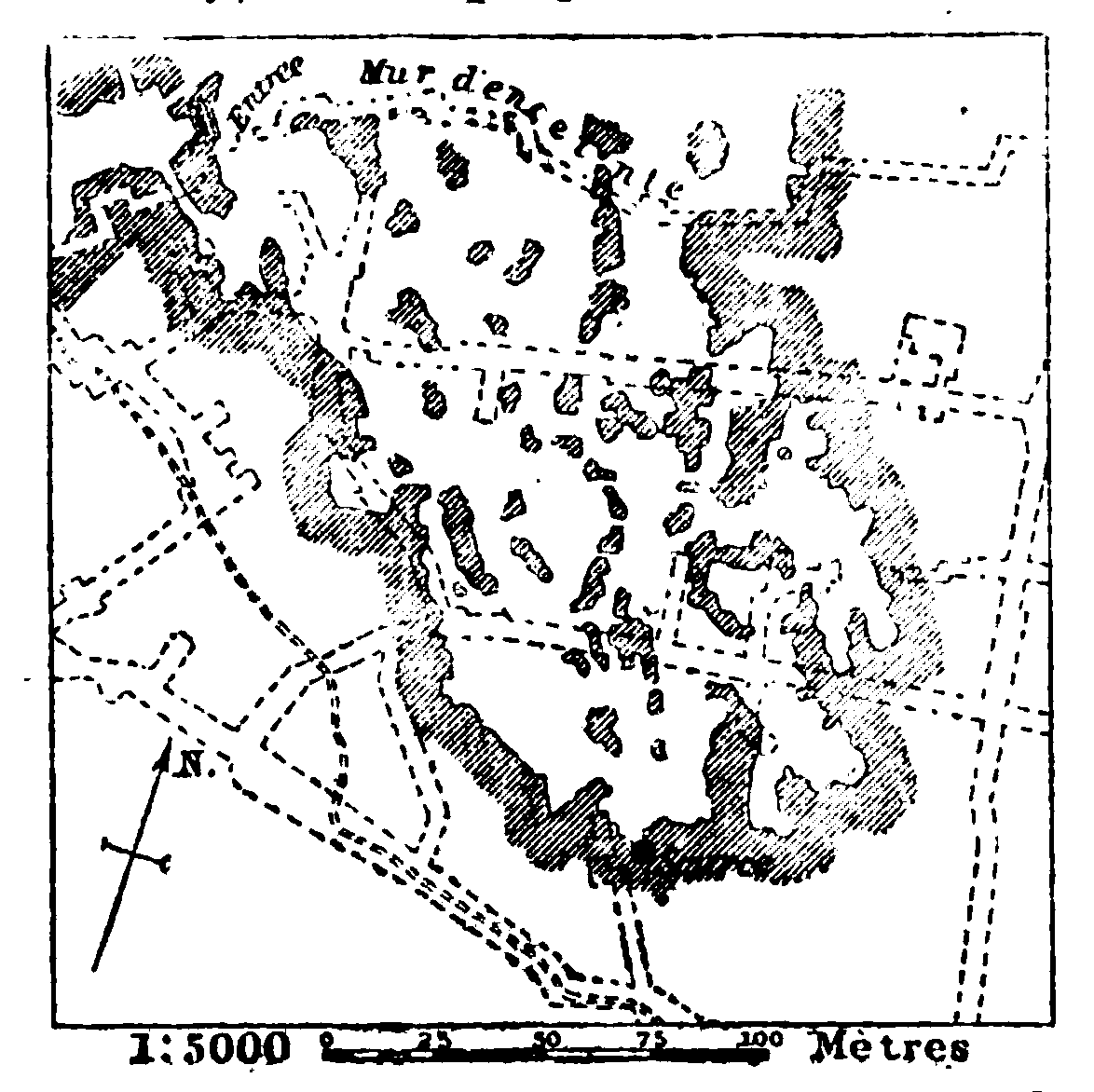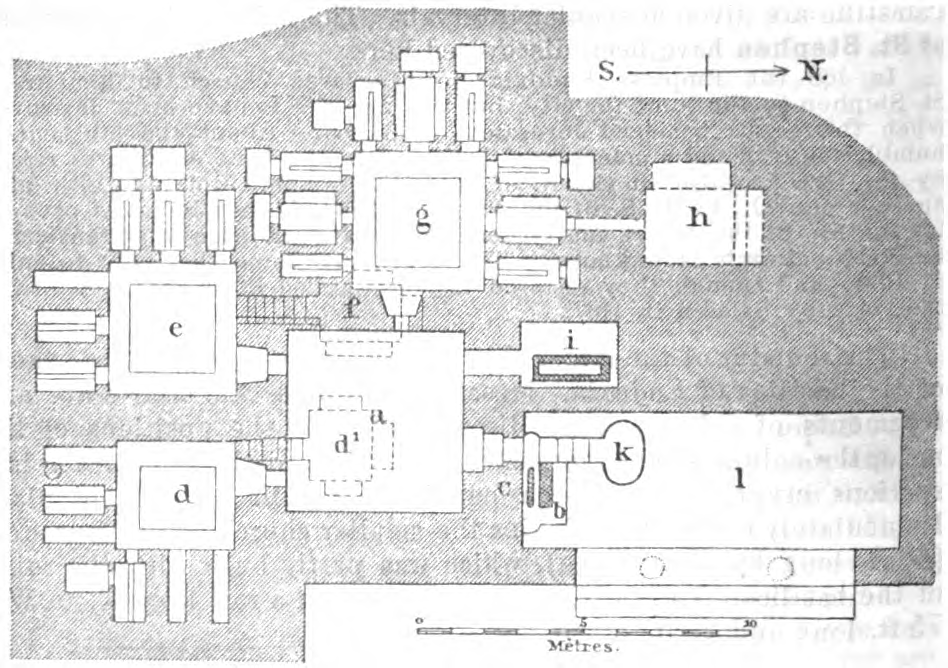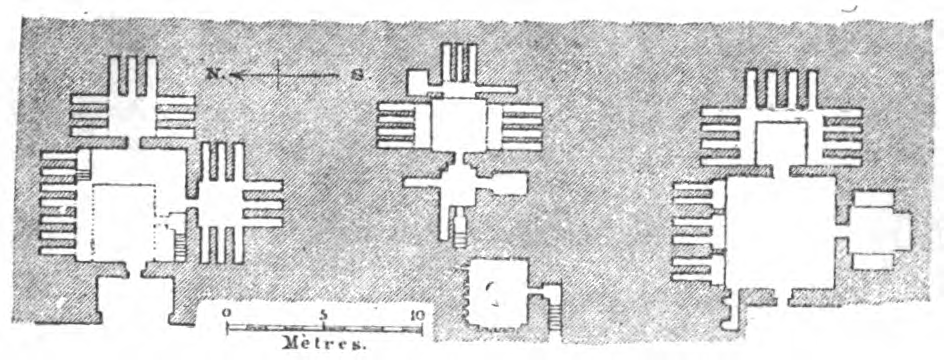Palestine and Syria: Handbook for Travelers
Carriage-road as far as the Tombs of the Kings. It is necessary to take a light when visiting the different caverns. — The key to the Cotton Grotto must he procured (through the landlord of the hotel) from the Serai, whence a guide will also he sent (fee 6-9 pi., or more in proportion for a party).
We leave the town by the Damascus Gate, which with its battlements is a fine example of the architecture of the 16th century. According to the inscription it was built, or at least restored, by Soliman in the year 944 of the Hegira (beginning 10th June, 1537). On each side of the inside of the gate are very slender columns, above which is a pointed pediment with an inscription. From these columns (or perhaps from the small tapering columns on the battlements) the gate is called Bâb el-'Amud, or 'gate of the columns'. The tower of the gate commands a celebrated view. In the 12th cent, the gate was called St. Stephen's Gate (p. 106). Excavations here have elicited the fact that the gate undoubtedly stands on the site of an ancient gate, as a reservoir and a fragment of wall (running from E. to W.) constructed of drafted blocks have been discovered here. Outside the gate we can still clearly see on our right (E.) ancient courses of drafted blocks; when the gateway was rebuilt the Turks had grooves cut in the blocks to make them look more modern. The Damascus Gate is built in an angular form. It consists, properly speaking, of two gate-towers, between which there are distinct traces of an ancient gateway, or, at least, of the upper part of the arch of the gateway. Under the gates there still exist subterranean chambers. That of the E. tower is 15 paces long and 9 paces wide, and is built of large blocks. The rushing of a subterranean water-course is said to have been frequently heard below the Damascus Gate, and it is not improbable that one may exist here.
The open space in front of the Damascus Gate is the point where four roads meet. On the left is the road skirting the wall from the Jaffa Gate, and descending on the right into the valley of the Kidron. Straight before us (N.) is the road to Nâbulus (p. 105) ; the road to the N.W. leads between Jewish colonies to the Jaffa road (p. 82).

We skirt the wall in an easterly direction. About 100 paces to the E. of the Damascus Gate, there is in the rock, 19 ft. below the wall, the entrance to the so called Cotton Grotto, discovered in 1852. This cavern is called the linen grotto (maghâret el-kettân) by Muslim authors, and it corresponds to the 'royal grottoes' of Josephus (Bell. Jud. V. 4, 2). It is an extensive subterranean quarry, stretching 213 yards in a straight line below the level of the city, and sloping considerably down towards the S. On the sides are still seen niches for the lamps of the quarrymen. The rocky roof is supported by huge pillars. The blocks were separated from the rock by means of wooden wedges, which were driven in and wetted so as to cause them to swell ; and traces of this mode of working the quarry, are still distinguishable. We possess no clue as to the period when the quarry was used. On one of the walls is a kind of cherub in the Assyrian style (a four-footed being with a human head). There is a trickling spring on the right side, but the water is bad.
Exactly opposite the Cotton Grotto, and a little to the N. of the road, is the so-called Grotto of Jeremiah (el-Edhemîyeh). This is now a Muslim sanctuary, and a wall is built across the entrance. The Muslim custodian often makes extortionate demands before he will open the door, but becomes reasonable when the traveller turns to go away (6 pi.). We first enter a small open court planted with fruit-trees , a view of which can also be obtained from the hill. Fragments of columns are scattered about here. Passing through a place of prayer we are conducted into a cavern towards the E., and then into a second , circular in shape, about 40 paces long and 35 wide, and supported by a pillar in the centre. To the S.W. we are shown the tomb of the Sultan Ibrahim, and beyond it a lofty rockshelf, with a tomb, which since the loth cent, has been called the tomb of Jeremiah. The prophet is said to have written his Lamentations here. These caverns were once inhabited by Muslim santons or monks. — In the S.E. angle of the court there is an entrance and a descent of 7 steps to a vault borne by a short, thick column, beyond which a passage like a door leads to the N. We find here a large and handsome cistern, with its roof supported by a massive pillar, and lighted from above. Steps lead down to the surface of the water. — The Cotton Grotto and the Grotto of Jeremiah were probably originally parts of the same quarry, and a ridge of rock may have once extended from this point to the town-wall, and been afterwards removed to increase the strength of the fortifications. — As already mentioned (p. 59) several English authorities (including the late General Gordon) regard the hill immediately above the Grotto of Jeremiah as the true Golgotha, and one of the rock-tombs there as the Holy Sepulchre.
We return to the Damascus Gate and take the Nâbulus Road (p. 248). About 390 yds. from the gate is a high wall, on the right, enclosing the extensive possessions of the Dominicans. These include a church, a monastery, and the 'Ecole Biblique', a theological seminary, where public lectures on the archæology and history of Palestine are given at regular intervals. The ruins of two Churches of St. Stephen have been discovered here.
In 460 the Empress Eudoxia built a large church in honour of St. Stephen to the N. of the city, but this appears to have been destroyed when the Arabs besieged Jerusalem in 634-637. About the 8th cent, a humbler church and a monastery, dedicated to the same saint, was raised by the Greeks, also to the N. of the city. At that time and also later another church, to the S. of the Church of Zion, is mentioned as occupying the site of the saint's martyrdom. When the tradition was transferred to the N. church is unknown. The Crusaders found the latter in ruins in 1091, and though they restored it, they pulled it down again during the siege by Saladin in 1187.
The remains of the larger church found here, to the E., are those of the basilica of Eudoxia. Mosaic pavements, the altar-slab, and fragments of columns were discovered, and the positions of the apse, the columns, and the aisles were quite distinct. Beneath is a spacious crypt. The church has been rebuilt on the old plan. Immediately to the W. of it lies the smaller church of the Crusaders (66 ft. long by 23 ft. wide), which was partly built with the ruins of the basilica. To the N. are four vaults, in a row from E. to W., 75 ft. long and 26 ft. broad.
We now proceed along the Nâbulus road till we come to a crossroad (5 min.). A few paces to the E. of the cross-road are the socalled Tombs of the Kings, Arab. Kubûr es-Salâtin. They belong to the French and are surrounded by a wall (fee to the custodian 5 p., more for a party). We enter from the W. side. A rock-hewn staircase of 24 steps, 9 yds wide, leads down into the tombs in an E. direction. We here observe channels cut in the rock for conducting water to the cisterns below; these cross the staircase at the 10th and 20th steps and lead down beside the wall to the right.
At the foot of the staircase we observe the beautiful cisterns, which have now been repaired; the smaller is on the right; straight before us is a much larger one, with a double-arched entrance in the wall of the rock. The roof is slightly vaulted and supported by a pillar. At the corners of each cistern are steps for drawing water. On the left is a round-arched passage which leads hence through a rocky wall, 4 1/2 ft. thick, down three steps into an open court hewn in the rock, 30 yds. long and 27 yds. wide. We now at length perceive to the W. the richly hewn portal of the rock-tombs. The portal has lately been widened to 38 ft.; like that of St. James's grotto (p. 95), it was formerly borne by two columns, which relieved the open space. Some of the mouldings of the portal are still In admirable preservation , consisting of a broad girdle of wreaths , fruit, and foliage.
In the vestibule (1) are fragments of columns, capitals, and fragments of sarcophagi. We cross over a round cistern (k) and descend a few steps ; on our left is an angular 'passage (b) with a movable rolling stone (c) by which the entrance to the tomb could be closed.

The chamber a is about 6 1/2 yds. square, and from it four entrances, two to the S., one to the W., and one to the N., lead to tomb-chambers. The S.E. chamber (d) contains rock-shelves on three sides, and shaft-tombs (p. cxi) on the E. and S. In the N.W. angle we descend by 4 steps into a lower chamber (d') with 3 shelf tombs. The second chamber (e) has a depression in the middle, three shaft-tombs on the S.. and three on the W.; this chamber also has a subsidiary chamber (f). The chamber (g) to the W. of the vestibule contains two shaft-tombs on the right and on the left, in addition to the shelves in the walls. In the middle is a passage leading to a small chamber with 3 shelf-tombs. From this chamber in the N. wall a passage leads farther down to a larger apartment (h), in which is a vaulted niche-tomb on the left, and a double shelf at the back. The different chambers bear distinct traces of having once been closed by properly fitted stone doors. The chamber i to the right of the principal entrance once contained a richly decorated sarcophagus (now in the Louvre).
These catacombs are revered by the Jews, who from a very early period have called them the Cavern of Zedekiah, or the Tomb of the rich Kaiba Sabua, a noble who lived at the time of the Roman siege. It is most probable however, that this is the Tomb of Queen Helena of Adiabene which, according to Josephns (Ant- xx. 4, 3), was situated here. This queen, with her son Izates, became converted to Judaism and for some time resided at Jerusalem, where she had a palace. Helena and Izates were buried in a handsome tomb with three pyramids, situated three stadia from Jerusalem, which was so famous that Pausanias compares it with the tomb of Mausolus. Izates had twenty-four sons, and hence the extent of the tomb. A sarcophagus, found by De Saulcy, bore an Aramaic inscription (in which the name of Queen Zaddo occurs) in Syriac and Hebrew characters, a proof that this Jewish queen belonged to a Syrian royal family, viz. that of Adiabene. These vaults were understood to be tombs as early as the 14th cent., and they were sometimes referred by tradition to the early kings of Judah, whence they are still called Tombs of the kings'.
To the N. of the Kings* Tombs (to the right of the Nâbulus road), lie the house of the sect of the Overcomers (p. 36) and the weli of Shekh Jerrâh. Farther on, crossing over the flat bed of the upper valley of the Kidron (Arab. Wâdi el-Jdz^ the valley of nuts), we pass a Jewish colony on the left, and on the right come to graves in the rock, among which Ihe so-called grave of Simon the Just should be noticed. The Jews make pilgrimages to this spot. These is another Jewish colony to thei N.
I. Tombs on level of ground. II. Basement. III. Upper series of tombs.

The road to the Tombs of the Judges, Kubur el-Kudât, which leads on to En-Nebi Sarawil, branches off to the N.W. (left) from the Nâbulus road opposite the Church of St. Stephen (p. 105) and reaches the tombs in about 35 min. from the town. From the Tombs of the Kings we go in the diiection of the minaret of En-Nebi Samwil. After about !/2 hr- we observe the entrance to the tombs in the rock on the right of the road, A forecourt, ftl/2~7 ft. wide, has been hewn east wards in the rock; the vestibule is 12 ft wide, open in front, and provided with a gable. In the pediment is a ring from which pointed leaves extend in the form of rays. There is also a pediment over the portal leading into the tomb-chamber. The portal was once capable of being closed from within. The S.E. and N.W. corners of the first tomb-chamber arc imbedded in rubbish. On the left (N.) side of it are seven shaft-tombs, above which, at irregular distances, are three vaulted niche-tombs; and at the back of these there are two other shaft-tombs. In the "W. wall is a niche. Adjoining this first chamber on the E. and S. (PI. 1) are two others on about the same level, and two on a lower level (PI. II). On each of three sides of the E. chamber are three shaft-tombs on a level with the ground (PI. I), and 3 ft. above these (PI. Ill) are four more of the same kind. The S. chamber has on each of three sides three shaft-tombs, and above these a long vaulted niche-tomb. From the first chamber a passage , with three shaft-tombs , descends to the N.E. chamber, which contains five shaft-tombs on the N. , five on the S., and three on the E. side. The subterranean side chamber to the S.W. was originally a quarry. The myth that the 'Judges of Israel' are buried here is of modern origin. These chambers have also been styled 'tombs of the prophets' Kubur tl-Anbiyd, and by others are assigned to members of the Jewish courts of justice. — There are other rock-tombs in the vicinity, but none of so great extent.
We return by the road from En-Nebi Samwil to the Damascus Gate, or we turn by a hill of ashes into a path to the right, which takes us past St. Paul's (p. 82) to the Jaffa road.